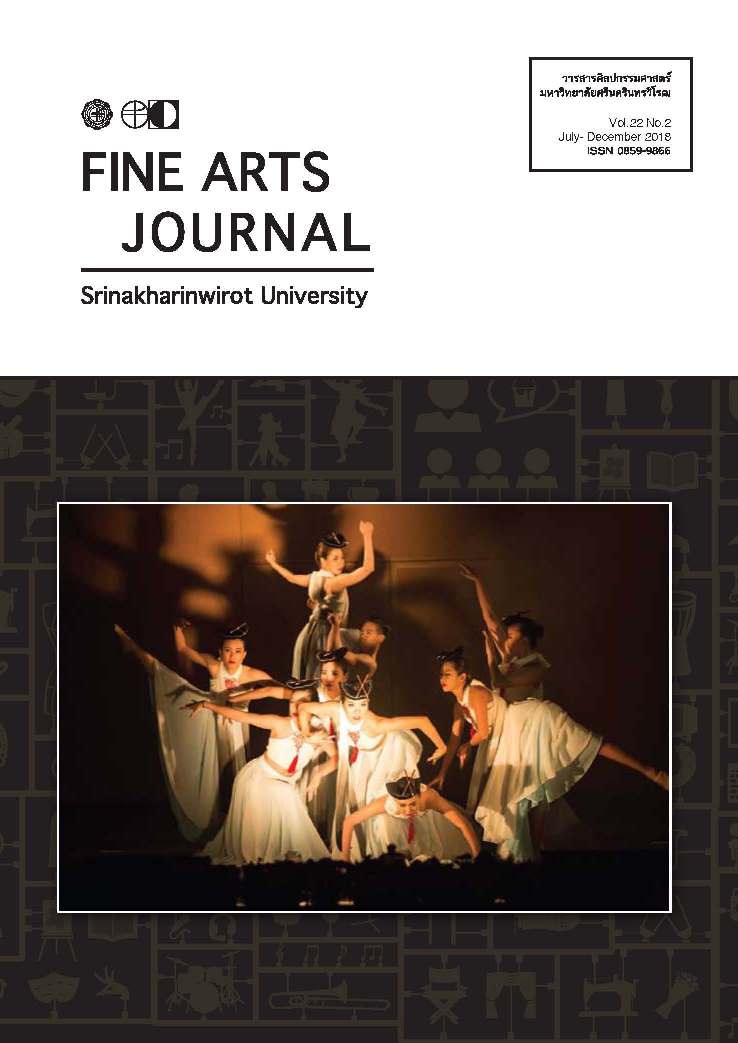การพัฒนาความสามารถทางดนตรีด้วยเทคนิคอเล็กซานเดอร์
Keywords:
music education, Alexander Technique, music practiceAbstract
The research aims to study the results of the development of teaching and learning ability by using the method of Alexander Technique, and to study music students’satisfaction
towards the Alexander Technique. The researchers collected all data including Literature review, Theory of Education, Theory of Music Education, Music and the Development of Physical and Mental Skills, How to Teach Music Instruments, Alexander Technique in music teaching including books and all related research in the area. The researchers have attended a workshop about Alexander Technique given by Miss Ayumi Akashi and also the researchers apply and design activity in teaching Alexander Technique in assigned music class. The results are as follows:
The development of teaching and learning music ability by using the method of Alexander Technique can be divided in 4 parts such as the development of mental skill, physical ability, music practices, and music performances. The students are satisfied in learning and doing activity towards the Alexander Technique. For instance, the satisfaction in learning atmosphere; the session ; the content and the method make such a creatived way and relaxing in practice music. The benefit of learning Alexander Technique can help music students not only relax their own body and mind, but also develop their own music technique in progress way.
References
ในการจัดตั้งศูนย์วิทยบริการด้านนวัตกรรมและเทคโนโลยีทางการศึกษาสำหรับสายงาน
ด้านมัธยมศึกษา.กรุงเทพฯ : บริษัทต้นอ้อแกรมมี จำกัด.
โกวิทย์ ขันธศิริ.(2550). ดุริยางคศิลป์ตะวันตก (เบื้องต้น). กรุงเทพฯ: จุฬาลงกรณ์มหาวิทยาลัย.
จงรัก พุกกะณานนท์.(2542).หลักการสอนเปียโน.กรุงเทพฯ:สำนักพิมพ์โอเดียนสโตร์.
จิตราภา กุณฑลบุตร (2550). การวิจัยสำหรับนักวิจัยรุ่นใหม่. (พิมพ์ครั้งที่1).กรุงเทพมหานคร:
โรงพิมพ์บริษัทสหธรรมิก จำกัด.
ณรุทธ์ สุทธจิตต์. (2535). จิตวิทยาการสอนดนตรี. (พิมพ์ครั้งที่ 3). กรุงเทพมหานคร: สำนักพิมพ์
จุฬาลงกรณ์มหาวิทยาลัย.
ณรุทธ์ สุทธจิตต์. (2537). หลักการของโคดายสู่การปฏิบัติ : วิธีการด้านดนตรีศึกษาโดยการสอน
แบบโคดาย. (พิมพ์ครั้งที่ 3). กรุงเทพมหานคร: สำนักพิมพ์จุฬาลงกรณ์มหาวิทยาลัย.
ณรุทธ์ สุทธจิตต์. (2540). สังคีตนิยม : ความซาบซึ้งในดนตรีตะวันตก. (พิมพ์ครั้งที่ 5).
กรุงเทพมหานคร: สำนักพิมพ์จุฬาลงกรณ์มหาวิทยาลัย.
ณรุทธ์ สุทธจิตต์.(2545). ดนตรีคลาสสิค บทเพลงและการขับร้อง. กรุงเทพฯ : กรมวิชาการ
กระทรวงศึกษาธิการ
ณัชชา โสคติยานุรักษ์.(2554). พจนานุกรมศัพท์ดุริยางคศิลป์. (พิมพ์ครั้งที่ 4). กรุงเทพมหานคร :
จุฬาลงกรณ์มหาวิทยาลัย.
ณัชชา พันธุ์เจริญ. (2538). พื้นฐานทฤษฎีดนตรี.กรุงเทพฯ: กรมวิชาการ กระทรวงศึกษาธิการ
ดวงใจ อมาตยกุล. (2546). การขับร้องประสานเสียง. (พิมพ์ครั้งที่ 2). กรุงเทพฯ : สำนักพิมพ์แห่ง
จุฬาลงกรณ์มหาวิทยาลัย
ธวัชชัย นาควงษ์. (2543). การสอนดนตรีสำหรับเด็ก. (พิมพ์ครั้งที่ 1). กรุงเทพมหานคร :
สำนักพิมพ์มหาวิทยาลัยเกษตรศาสตร์.
ธวัชชัย นาควงษ์.(2544). โคไดสู่การปฏิบัติ. กรุงเทพฯ: สำนักพิมพ์มหาวิทยาลัยเกษตรศาสตร์.
ประสิทธิ์ เลียวสิริพงศ์.(2545). ปทานุกรมดนตรีสากล. เชียงใหม่ : สำนักพิมพ์The Knowledge
Center.
พระเจนดุริยางค์. (2509). แบบเรียนวิชาประสานเสียง. พิมพ์ครั้งที่ 3. กรุงเทพมหานคร : พระจันทร์
ล้วน สายยศ และ อังคณา สายยศ. (2538). เทคนิคการวิจัยทางการศึกษา. (พิมพ์ครั้งที่ 5).
กรุงเทพมหานคร : สุวีริยาสาสน์.
วิรัช ซุยสูงเนิน. (2520). ดนตรีเบื้องต้นสำหรับครูประถม.(พิมพ์ครั้งที่ 2). พิษณุโลก :
มหาวิทยาลัยศรีนครินทรวิโรฒ.
สมชาย อมะรักษ์. (2529). ทฤษฏีดนตรีสากลเบื้องต้น. กรุงเทพมหานคร : สำนักพิมพ์
โอเดียนสโตร์.
สุกรี เจริญสุข. (2532). จะฟังดนตรีอย่างไรให้ไพเราะ. (พิมพ์ครั้งที่1). กรุงเทพมหานคร : เรือน
แก้วการพิมพ์.
สุธาทิพย์ ทาฟู(ม.ป.ป.).หนังสือเรียน.สืบค้นเมื่อวันที่ 10 กรกฎาคม 2560,จาก
http://sps.lpru.ac.th/script/show_article.pl?mag_id=5&group_id=23&article_id=191
สุรางค์ โค้วตระกูล. (2542) จิตวิทยาการศึกษา (พิมพ์ครั้งที่ 4) กรุงเทพมหานคร :สำนักพิมพ์
จุฬาลงกรณ์มหาวิทยาลัย.
สุวิชญ์ ปรัชญาปารมิตา. เทคนิคอเล็กซานเดอร์. สืบค้นเมื่อวันที่ 10 กรกฏาคม 2560, จาก
http://www.healthcarethai.com
อรวรรณ บรรจงศิลป. (2538).การสอนดนตรีในระดับประถมศึกษา. กรุงเทพฯ: จุฬาลงกรณ์ มหาวิทยาลัย
อารี สุขะเกศ.(2539). เรียบเรียงเสียงประสาน ยากนักหรือ เล่ม 1. มปท. : มปพ.
ไวพจน์ จันทร์เสม. วิทยาศาสตร์การกีฬากับการพัฒนาการกีฬา Sports Science in Sports
Development. วารสารวิชาการ สถาบันการพลศึกษา ปีที่ 7 ฉบับที่ 1 มกราคม – เมษายน
2558
Barbara, C. (1995). How to Learn the Alexander Technique: A Manual for Students. (3rd Edition ).
Portland : Andover Press.
Clark, F.(1992). Questions and Answers. Illinois : Instrumentalist Company.
Choksy, L.(1999). The Kodaly Method I. (1st Edition). New Jersey : Prentice-Hall, Inc.
Choksy, L.(1999). The Kodaly Method II.(3rd Edition).New Jersey : Prentice-Hall, Inc.
Colwell, R. (2005). HANDBOOK OF RESEARCH ON MUSIC TEACHING AND LEARNING
VOLUME I. (1st Edition). New York : Mazwell press.
Frank Pierce J. A Technique for Musicians. Available:
http://www.alexandertechnique.com/articles/jones2.
EDM Sauce Available: https://www.edmsauce.com/electronic-dance-music-guide-and-definitions/
Hugh M. (2013). Alexander Technique Lessons, Acupuncture Sessions or usual care for
patients with chronic neck pain (ATLAS): study protocol for a randomised
controlled trial. Department of Health Sciences, University of York, York, UK.
Joan A. and Hope G. Posture and the Alexander Technique. Available:
http://www.alexandertechnique.com/articles/posture.
Jane, H. (2011). Voice and the Alexander Technique. Berkeley : Mornum Time Press.
Jeshua S. F. (2016). A Way of Doing Things: Exploring and Applying the Alexander Technique for
Choral Conductors. A dissertation submitted in partial fulfillment of the requirements
for the degree of Doctor of Musical Arts University of Washington.
Lovelock, W. (1978). The Rudiments of Music. West Sussex, United Kingdom.
Louis ,S.(1960). Instructional Materials : An Introduction for Teachers. New York : The Ronald.
Melissa, M. (2012).What Every Singer Needs to Know About the Body. (2nd Edition ).
Oklahoma : Plural Publishing.
Michael G. (1994) Body Learning : An Introduction to the Alexander Technique. Great Britain :
Aurum Press.
Neely, D. W. (2012). Body Conscious : A Comparative study of body awareness and body
alignment methods for singers and for teachers integrating. Alabama :University
of Alabama Libraries.
Pedro de A. (2013). Indirect Procedures: A Musician's Guide to the Alexander Technique (The
Integrated Musician. New York : Oxford University Press.
Ricigliano, D. (1978). Popular and Jazz Harmony for: Composers, Arrangers, Performers
Illinois : Music Exchange
Sabine, D. and Claudine, B.(2013) The Alexander Technique and musicians: a systematic review
of controlled trials. Institute of Complementary Medicine, University of Bern,
CH-3010 Bern, Switzerland.
Suzuki, S. (1983). Nurtured by Love , The Classic Approach to Talent.
Education. (2nd Edition). Miami: Warner Bros. Publication Inc.
Valentine E, Fitzgerald D, Gorton T, Hudson J,(1995). The Effect of Lessons in the Alexander
Technique on Music Performance in High and Low Stress Situations. Psychology of
Music, Vol. 23, No. 2, 129-141.
Webster, N. (1984). New Webster's Dictionary of the English Language. New York: the Deair
Publishing Company, Inc
Wendy, N. (1990). The Alexander principle: A consideration of its relevance to early
childhood education in England today. Leeds Metropolitan University , England.
Winslow, R. and Dallin, L. (1975).Music Skill for Classroom Teachers. Iowa : WM.C.
Company Publishers.



